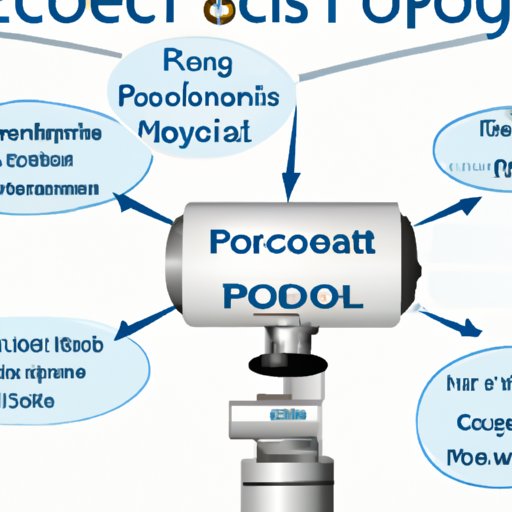Introduction
Robotic surgery is a minimally invasive surgical technique used to treat a variety of medical conditions, including prostate cancer. It involves the use of a robotic device that is operated by a surgeon from a remote console. The robot’s arms are equipped with miniature instruments that allow the surgeon to perform complex procedures with greater precision, accuracy, and speed than traditional open surgery.
The purpose of this article is to provide an overview of robotic surgery for prostate cancer, its benefits and risks, how it compares to other treatments, what to expect during a procedure, the latest advances in the field, how to choose the right surgeon, and post-surgery care and recovery.

Overview of Robotic Surgery for Prostate Cancer
Robotic surgery is a minimally invasive surgical technique used to treat prostate cancer. During the procedure, the surgeon sits at a remote console and uses robotic arms to maneuver miniature instruments inside the patient’s body. The robot’s arms are designed to be more precise and flexible than a human hand, allowing the surgeon to perform complex operations with greater accuracy and speed.
Robotic surgery has several advantages over traditional open surgery. For example, it results in less blood loss, shorter hospital stays and recovery times, and smaller incisions. In addition, robotic surgery can be performed on an outpatient basis, which means the patient can go home the same day as the procedure.
Benefits and Risks of Robotic Surgery for Prostate Cancer
Robotic surgery offers a number of potential benefits for patients with prostate cancer. Compared to traditional open surgery, robotic surgery is less invasive, resulting in less pain, fewer complications, and faster recovery times. In addition, the robot’s arms are able to reach difficult-to-reach areas of the body with greater precision and accuracy than a human hand.
However, there are also some risks associated with robotic surgery for prostate cancer. These include the risk of infection, bleeding, and nerve damage. Additionally, robotic surgery is a relatively new technology and may not be available in all areas. As such, it is important to discuss the risks and benefits of robotic surgery with your doctor before deciding if it is the right option for you.
How Robotic Surgery Compares to Other Prostate Cancer Treatments
When it comes to treating prostate cancer, there are a few different options available. Traditional surgery, radiation therapy, and hormone therapy are all commonly used methods. Each of these approaches has its own set of benefits and risks, and it is important to discuss these with your doctor in order to make an informed decision.
Compared to traditional surgery, robotic surgery offers a number of advantages. It is less invasive, resulting in less pain, fewer complications, and faster recovery times. Additionally, the robot’s arms are able to reach difficult-to-reach areas of the body with greater precision and accuracy than a human hand.
Radiation therapy is also an option for treating prostate cancer. Radiation therapy involves using high-energy beams to kill cancer cells. While it is generally less invasive than traditional surgery, it can cause side effects such as fatigue, skin irritation, and hair loss. In addition, radiation therapy may not be effective for all types of prostate cancer.
Hormone therapy is another option for treating prostate cancer. This involves taking medications that block the production of hormones that fuel the growth of prostate cancer cells. While hormone therapy can be effective, it can cause side effects such as weight gain, hot flashes, and decreased sex drive.

What to Expect During a Robotic Surgery Procedure
Before undergoing robotic surgery for prostate cancer, it is important to understand what to expect during the procedure. The process typically begins with pre-operative steps such as blood tests and imaging scans. This helps the surgeon plan the operation and ensure the best possible outcome.
During the operation, the surgeon will use the robotic arms to maneuver miniature instruments inside the patient’s body. The robot’s arms are designed to be more precise and flexible than a human hand, allowing the surgeon to perform complex operations with greater accuracy and speed.
After the operation is complete, the patient will begin the post-operative steps. This includes monitoring the patient’s vital signs, administering medication as needed, and providing instructions for post-operative care. Most patients can return home the same day as the procedure.
The Latest Advances in Robotic Surgery for Prostate Cancer
In recent years, there have been a number of advances in robotic surgery for prostate cancer. These include minimally invasive techniques, enhanced accuracy, and improved recovery times. For example, surgeons can now use advanced imaging systems to guide the robot’s arms, allowing for greater accuracy and precision during the operation.
In addition, robotic surgery can now be performed on an outpatient basis. This means that the patient can go home the same day as the procedure, reducing the risk of infection and speeding up the recovery process.

How to Choose the Right Surgeon for Robotic Surgery for Prostate Cancer
Choosing the right surgeon for robotic surgery for prostate cancer is an important step in ensuring the best possible outcome. When selecting a surgeon, it is important to research their experience and qualifications. You should also ask questions about their success rate and any potential complications.
It is also important to find a surgeon who is experienced in performing robotic surgery. Ask your doctor for referrals or look online for reviews of local surgeons. Make sure to interview several surgeons before making your final decision.
Post-Surgery Care and Recovery After Robotic Surgery for Prostate Cancer
Once the robotic surgery is complete, it is important to focus on post-surgery care and recovery. This includes following up with your doctor regularly, managing pain and other symptoms, and following a healthy diet and exercise routine. Your doctor may also recommend hormone therapy or radiation therapy to help reduce the risk of recurrence.
It is also important to be aware of any potential complications or side effects from the surgery. These can include infection, bleeding, and nerve damage. If any of these occur, it is important to seek medical attention immediately.
Conclusion
Robotic surgery is a minimally invasive form of prostate cancer treatment that offers a number of potential benefits. Compared to traditional open surgery, robotic surgery is less invasive, resulting in less pain, fewer complications, and faster recovery times. In addition, the robot’s arms are able to reach difficult-to-reach areas of the body with greater precision and accuracy than a human hand.
However, there are also some risks associated with robotic surgery for prostate cancer. These include the risk of infection, bleeding, and nerve damage. Additionally, robotic surgery is a relatively new technology and may not be available in all areas. As such, it is important to discuss the risks and benefits of robotic surgery with your doctor before deciding if it is the right option for you.
When choosing a surgeon for robotic surgery, it is important to research their experience and qualifications. Additionally, it is important to follow up with your doctor regularly after the procedure and manage any pain or other symptoms. With proper post-surgery care and recovery, robotic surgery can be a safe and effective way to treat prostate cancer.
(Note: Is this article not meeting your expectations? Do you have knowledge or insights to share? Unlock new opportunities and expand your reach by joining our authors team. Click Registration to join us and share your expertise with our readers.)
